Then and Now: Cycling the Tour de France Route in 1957
Australian writer, Catherine Berry, talks to British cyclist, Peter Newman, about his personal 1957 Tour de France.
CB: In 1955, you were 22, living in the UK and hooked on cycling. You took part in a 15-day tour of the Cévennes (now part of Occitanie) with the British Cyclists’ Touring Club (CTC). Descending from the Massif Central to cross the Rhone, you could see snow-capped mountains in the far distance. At that point, you determined that you would organise a trip for your Archer Club members to see a future Tour de France on one of the high Alpine climbs. Can you tell us about this?
PN: I enjoyed my 1955 CTC trip as a participant, but I was itching to do the ‘impossible’ and organise an Archer Road Club tour myself. As I was a lowly paid junior bank clerk at the time, I had to save up for two years to be able to aford this 14-day holiday. Planning the 1957 itinerary and timing was exceedingly difcult. There was no coverage in any media in the UK to announce the Tour de France route, excepting Cycling magazine, which was published just a week prior to the Tour, and far too late to help us with arrangements. Most importantly, I needed the dates for the Tour’s big Alpine climbs as that is where we wanted to view the race. We managed to buy a French cycling magazine (But Club, Le Miroir des Sports) that showed that the best day to witness the Tour would be Sunday, the 7th of July 1957 when the stage was scheduled to include the North to South ascent of the Col du Galibier before finishing in Briançon. This input allowed me to book myself, my three companions and our bikes on an overnight fight from Heathrow to Geneva. At the time, bikes were carried free if the weight fell within your luggage allowance.
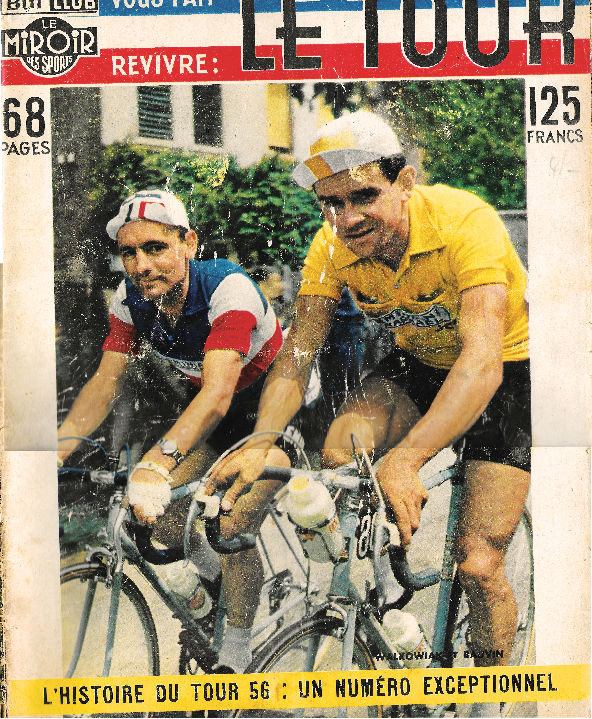
Image: Peter Newman archives
Despite serving two years in the RAF, I had never flown. The cruising height of the Vickers Viscount turbo jet airliner of that era was about 15,000 feet (today you could expect a cruising altitude of 30-45,000 feet). We were constantly in and out of clouds and the turbulence was noticeable, but it was a thrill as, through the very large oval windows, I could clearly see the fairytale lights of towns and cities below.
We planned our route in the winter of 1956 by studying large-scale Michelin fold-out maps of the areas, which we ultimately took with us to use as route finders. Simply put, we determined to ride seven days south from Geneva, turn around and ride seven days north, by a different mountainous route. Each day was planned to be around 50 miles and include one major mountain pass. With no chance of booking accommodation ahead of time, we just relied upon finding available hotel rooms at the end of each day’s ride.
Additionally, we knew that all French shops shut at midday for a long lunch, so it was important to mark the last village shown on the map that we would need to be before noon in order to buy our simple picnic food of bread, butter, cheese and fruit. Each of us carried two water bottles in a, then commonplace, handlebar cage. The plan was to refill the bottles from the village fountains that we passed by, or from the higher-level mountain streams which rushed under the roads. We didn’t even think about water quality and nobody suffered any untoward tummy incidents. It was hot, the blazing sun made us all exceptionally thirsty, so water replenishment was a constant concern and it was difficult to predict when we would come across the next stream. To add to the problem of thirst, our water bottles were made of aluminium and any stored water quickly became HOT.
CB: Did your party succeed in witnessing the passage of the Tour de France?
PN: Come Sunday July 7, 1957, we were roadside on the Galibier, as intended. We had not managed to reach the many successive, steep hairpins that constitute the final part of the climb, but we were above the tree line, on a long, fairly straight section of road with mainly grassy slopes both uphill and down, which assisted our visibility. The heat, though, was unremitting and we had neither hats nor sunscreen. Come to think of it, I don’t think I had heard of sunscreen at the time.
After what seemed an interminable wait, some motorbike outriders appeared. There was a sprinkling of French spectators dotted about and we managed to glean from them that the riders would be coming along shortly. Bearing in mind that the Tour had had a rest day the previous day, and although this stage was 153 miles long, we expected to see a bunch of riders, eager and ready to contest the final slopes.
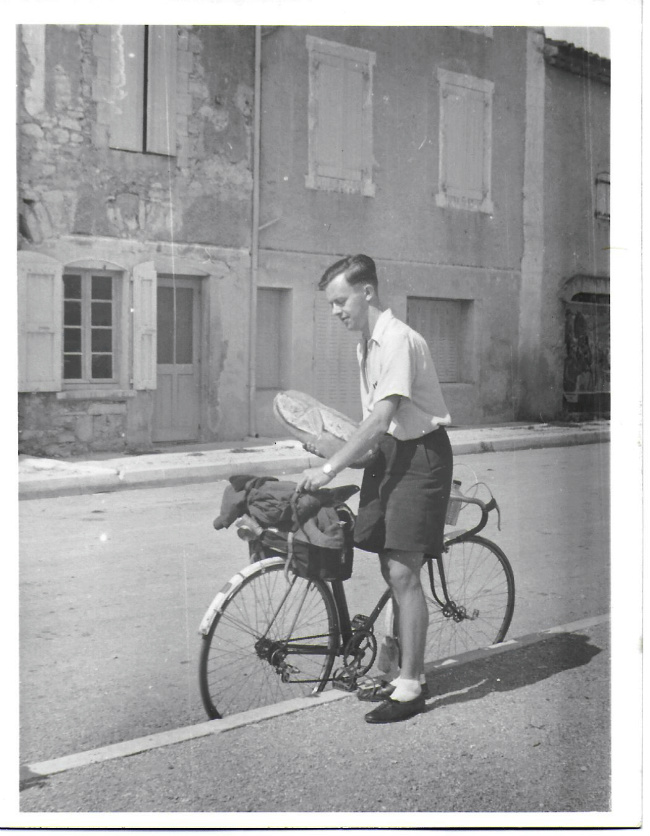
Peter Newman in 1957
But the weather had taken its toll. Haggard looking, the riders appeared in twos or threes or even on their own. Many individuals, in desperation, called for spectators to give them a push or a drink. The sag wagon with its broom prominently displayed eventually passed and this was the last thought that we gave to the Tour until we returned to the UK and could obtain a cycling magazine, which provided us with missing details, including who had won the event (Nencini by 90 seconds from Anquetil). Such was the state of communications back then and none of us gave it a moment’s thought. It was just the way of the world.
With the Tour riders out of sight, it was time for us to get back on our bikes. The remainder of the Galibier proved to be the steepest part of the climb. We were tremendously over geared with only four racing gears on our rear blocks. The lowest gear was by no means low enough and we were all suffering unknowingly from a touch of the sun, having been exposed to it at the high altitude for several hours. For my part, if there had been no spectators, I would have dismounted and walked to the top, but there was no lack of encouragement from the crowds and honour meant that I just had to keep going.
CB: This was postwar Europe. What was life in France like at this time?
PN: From what I could see, Alpine living in 1957 was simple and hotels were basic, but I had already encountered this during my ‘55 tour of the Cévennes. Then, all the road vehicles were of pre-war vintage; many dating back to the 1920s. By 1957, vehicles and farm machinery seemed to be more up to date.
Food and drink were never in any shortage, but there was no such thing as a supermarket, so we shopped in the tiny village épiceries and, of course, had to ask for what we needed. We did have one small pocket dictionary with us and, when that failed to help us with the required vocabulary, the shopkeepers were more than happy for us to jump to the other side of the counter and point to what we were after. This overcame verbal language difficulties although trying to decipher labels was still a baffling task.
Our saddlebags were full to overflowing with our two weeks supply of clothes, tools and spares for the bikes, so we always sought to purchase a large, circular loaf of bread with a hole in the middle, which could be safely threaded over our handlebars. We placed other food items in a bag called a musette, which we slung over our shoulders. After making our purchases, it was essential to get going quickly to seek a suitable quiet spot in the shade before the butter and cheese started to ooze away.
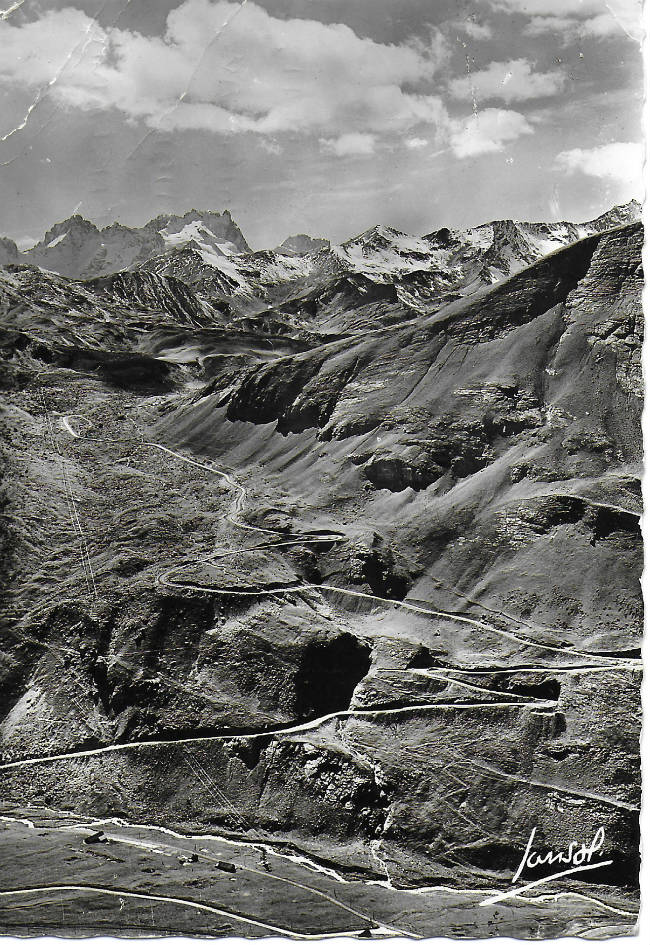
Postcard from Galibier. Image: Peter Newman archives
Our language abilities did improve over our two weeks, and on our final day’s ride back towards Geneva airport, we met an old, red-nosed, French farmer late in the afternoon, who was walking towards us on a small country lane. He was very happy to chat and when we told him that we were on our way back to London and that I would be at work behind the bank counter within 16 hours, he couldn’t believe it. Talk quickly turned to the (good) quality and availability of French wine.
As an aside: Throughout the 1939-45 war and for many years after, all inhabitants of the UK were subjected to very strict exchange control regulations enforced by the Bank of England. In essence, the amount of foreign currency that we could purchase for overseas holidays was limited to £25 each year. Any money drawn from your local bank had to be endorsed on the last page of your passport. The £25 limit was gradually increased, but it was always a very parsimonious figure. If all of that currency was not spent abroad, the surplus had to be handed in to your bank. It was a criminal offence to retain foreign currency, even if one intended to use it on a subsequent trip.
CB: Can you tell us about the bikes that you toured with?
PN: To take up cycling, I needed a racing bike. In basic terms, one with dropped handlebars and some gears. To buy one, which immediately after the war was a difficult proposition, required money and I had little spare. Somehow, I managed to put aside a few pennies from each month’s pay and I searched around for a suitable bike to purchase when the funds became available.
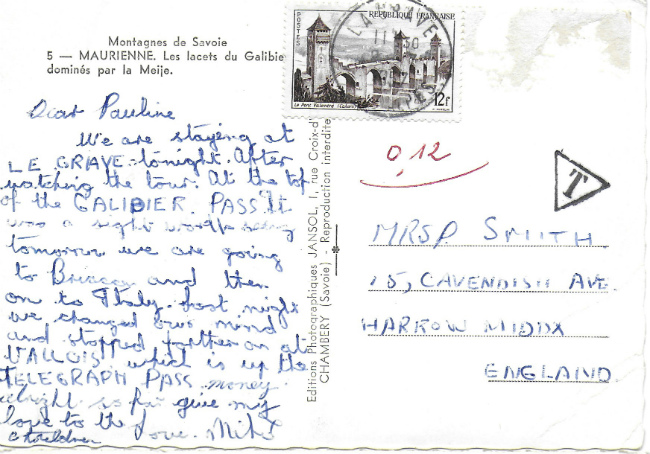
Postcard from the Col du Galibier. Image: Peter Newman archives
The bike I set my sights on was a Raleigh Clubman. I had seen it in the window of Halfords, in Wembley High Street and the exciting, sparkling machine, which included two aluminium water bottles in their cage on the middle of the handlebars, a saddlebag, mudguards, a pump, some spanners and tyre levers and toe clips (which made for more comfortable walking when you were of the bike) was priced at one penny shy of £25.
As per the top bikes of the time, the one that would be mine had a Reynolds 531 steel frame, a Brooks B17 leather racing saddle, and a Sturmey Archer fourspeed gear. Wheels were 27 inches and the fad was to have large flange alloy hubs for the front wheel. You can see in the photo of me that I had probably a two-inch hub. The idea (somewhat amusing given the bikes of today) was to save weight by having shorter steel spokes. We used the same tyres (clinchers) all year round. They were robust as proven by the fact that none of the four of us had a puncture on the 1957 tour.
As for clothing; you can see from my photo that we wore shorts and shirts to ride – no such thing as lightweight lycra.
CB: What were the most difficult parts of your ’57 tour?
PN: Climbing at altitudes over 2000 metres was always difficult as the air was shorter of oxygen and the sun shone more strongly on your skin and head. We didn’t realise any of that at the time. The Iseran was certainly the hardest climb as the road had been washed away in parts by floods weeks before our tour and therefore closed to all traffic.
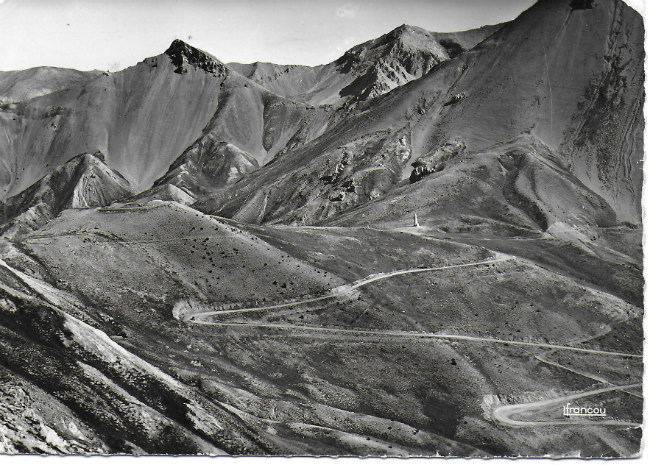
Postcard of the Col d’Izoard. Image: Peter Newman archives
Descending, too, was often very difficult, indeed scary. We couldn’t apply the brakes too hard as the rims would become so hot that it could lead to a complete blow out (an intimidatingly large bang due to the separation of the vulcanising that joined the tube’s two ends). Freewheeling at circa 50 mph, when this occurred to another rider, it was difficult to avoid a multiple pile up. The other chap managed to do a gigantic ‘bunny hop’ and threw himself and his bike into a solitary prickly bush, otherwise he would have gone tumbling down the mountainside.
CB: What were the best parts of your ’57 tour?
PN: All of it was fun, but the evenings relaxing in the hotels were always great occasions. Also off our bikes, a ski lift ride in Chamonix on what, at the time, was the highest ski lift in the Alps, was spectacular. In fact, the whole tour was so good, I had to arrange another trip for 1959.
CB: Cycling as a sport is growing in popularity. What do you put this down to?
PN: I think this has to do with professionalism and the money flowing into the televising of the cycling sport. Who, today, has not heard of the Tour de France? Also, in the ‘50s, you completed whatever event you participated in and then you had to ride home from the event’s venue. To give you an example of this, in order to keep fit, I participated in Reliability trials in the winter. I remember riding 15 miles to the start of an event, proudly receiving a certificate for completing 100 miles in 7 hours 30 minutes, and then hopping back on my bike to do the 15 miles home. You had to carry everything that you needed and there were no helpers handing things out along the way. Perhaps what I am saying is that it seems to have become much, much easier… but just as enjoyable and rewarding.
The images showcased in this article are from Peter’s personal collection. More of Peter’s story will soon be available in his memoir ‘Blitz, Bikes, Banking & Beyond’. He can be contacted on [email protected]
Australian-born Catherine Berry lived for several years on Annecy Lake with her family before buying a house in the lakeside village of Talloires. It is available for rental and is perfect for families and small cycling groups (sleeps 8). Take a look at www.ourfrenchvillagehouse.com for details. Her family’s story, ‘But you are in France, Madame’ can be purchased on Amazon.
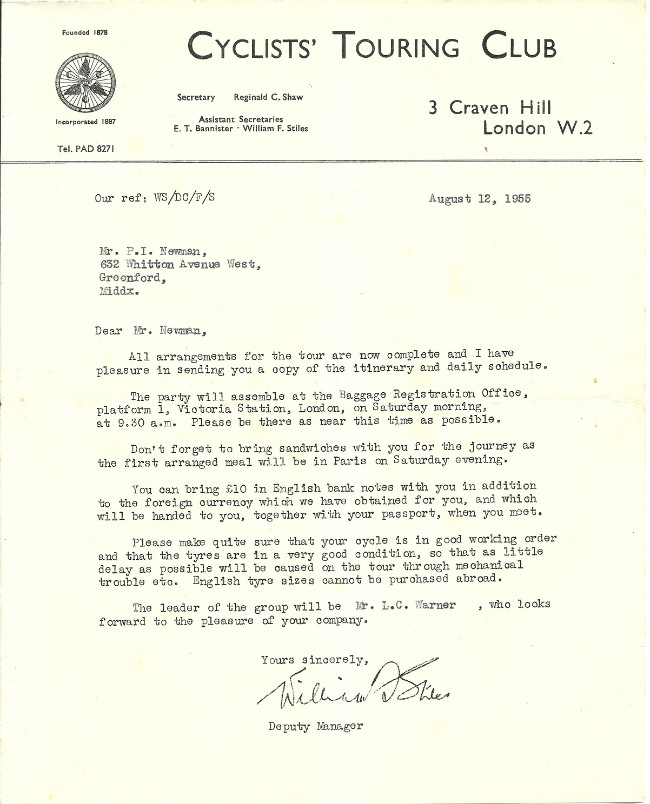
Image: Peter Newman archives
Share to: Facebook Twitter LinkedIn Email
Leave a reply
Your email address will not be published. Required fields are marked *

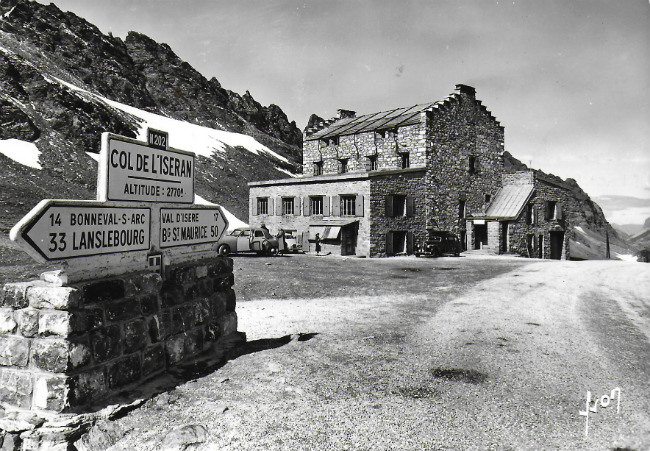
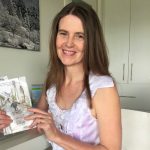


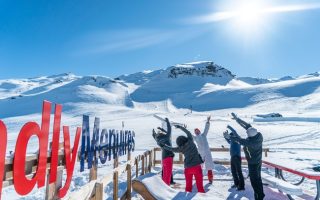
REPLY
REPLY
REPLY